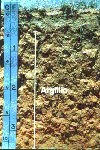 |
Argillic horizons are horizons of accumulated translocated silicate
clays. The term argillic is derived from the Latin word argilla,
meaning "clay."
|
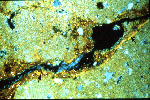 |
When a thin slice of an argillic horizon is viewed under a polarizing
microscope, the presence of translocated clay is confirmed. The
yellow areas in this thin section are the translocated clay-skins
or cutans.
|
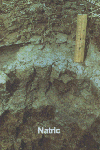 |
Natric horizons are argillic horizons that have high amounts of
exchangeable sodium. They frequently have columnar soil structure.
The tops of the columns are sometimes bleached, as shown here due
to clay removal. The term natric is derived from the Latin word
natrium meaning "sodium."
|
 |
Calcic horizons have pronounced accumulations of calcium carbonate,
or of calcium and magnesium carbonate. They are normally very light
in color and must meet specific criteria of carbonate content and
thickness.
|
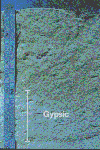 |
Gypsic horizons have significant accumulations of gypsum. Gypsum,
or calcium sulfate, is a moderately soluble salt - more soluble
than calcium carbonate but less soluble than sodium chloride. Gypsum
may restrict soil use, both for agricultural and engineering purposes.
|
 |
In this magnified view of a thin section of a gypsic horizon seen
under cross polarized light, white lenticular gypsum crystals fill
much of the void system of the soil.
|
 |
The thin white surface layer of this soil is part of a salic horizon.
Salic horizons contain accumulations of salts more soluble than
gypsum. These horizons must have soluble salt concentrations of
at lease 2 percent. Salts concentrate in salic horizons by capillary
rise and evaporation from shallow groundwater tables. The term salic
is derived from the Latin work sal meaning "salt."
|
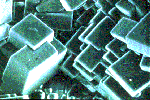 |
Note the cubic cleavage of the halite crystals in this scanning
electron micrograph of a salic horizon. The most common salts in
salic horizons are the chlorides and sulfates of sodium, calcium
and magnesium.
|
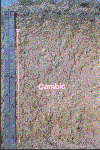 |
Cambic horizons are horizons in which minerals have been altered,
removed or accumulated but not to the degree necessary to meet criteria
for other diagnostic horizons. The origin of the term cambic is
from the Latin cambiare meaning "to exchange."
|
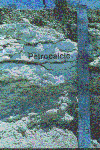 |
Petrocalcic horizons are cemented calcic horizons that are impenetrable
by plant roots. When they occur close to the surface, they present
major constraints for agricultural use.
|
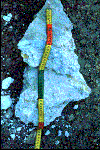 |
Petrocalcic horizons are rock hard and massive. The primary cementing
agent is calcium carbonate. The origin of the term petrocalcic is
from the Greek word, petra, meaning "rock." Other names
for petrocalcic horizons are croute calcaire, calcrete and caliche.
|
 |
Petrogypsic horizons are similar to petrocalcic horizons except
that the primary constituent is gypsum. Petrogypsic horizons are
common in North Africa and the Middle East.
|
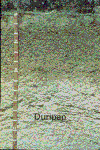 |
Duripans are soil horizons cemented by secondary silica. Like petrocalcic
and petrogypsic horizons, duripans present major constraints for
agriculture because they limit root growth and water movement.
|

